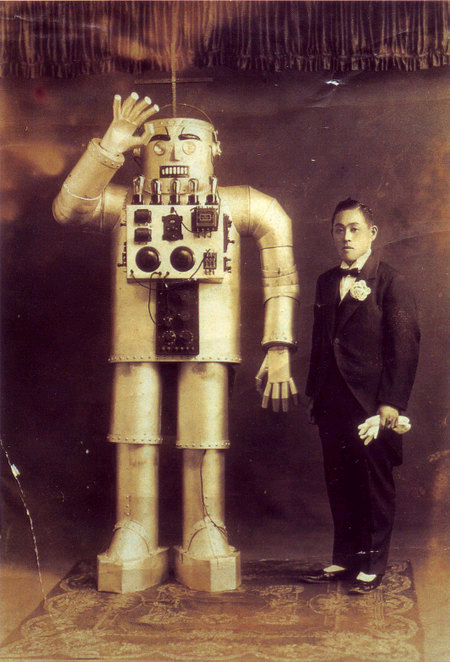So how is it intelligent?
Well, the fact that a robot can determine its own movements to accomplish a task makes it an intelligent machine. This intelligence is actually given by different sensors which allow the robot to manipulate its work as per changes in the environment. As per International Standard of Organisation (ISO), a Robot is a reprogrammable, multifunctional manipulator which is designed to move things with the help of variable programmed motions. Reprogrammable means a Robot is controlled through a computer-based program which can be changed at any time. Multi-functional attribute signifies the multiple number of applications carried out by a robot.
How did Robots evolve – A quick recap
It all commenced in 1921, when the Czech writer Karel Capek used the term ‘Robot’ to denote a human replaced machine, by a fictional character, in his play – Rossum’s Universal Robots. Though after effect of the play was, in fact, dreadful – Fear in the mind of people that Robots would eventually wipe out humans from the earth, it was Isaac Asimov, in 1940, who envisioned a robot as an asset to humans, by postulating the three basic laws: In 1958, Joseph F Engel Berger along with George C Devol founded the UNIMATION Robotics Company, which worked on designing the first ever working robot. However, it was a General Motors automobile company in New Jersey, in 1961, which first used an automated die-casting mould which dropped red-hot car parts into pools of cooling liquid, which transported them to workers for trimming and buffing.
Classification of Robots
Here, we are going to talk about different types of Robots as per different criterion. First and foremost, let us investigate some of the internationally approved classifications:
Classification by Japanese Industrial Robot Association (JIRA)
However, note that as per the Robotics Institute of America (RIA), only the last 4 types are Robots and not the first two.
Classification by Association Francoise de Robotique (AFR):
Classification as per Application
Industrial: Industrial robots are generally fixed manipulators which perform in various working environments. They perform various general-purpose tasks like Welding, Painting, machining, etc. In fact, the first robots were the industrial robots which were used for simple repetitive tasks.
Non-Industrial or Special Purpose: These are robots which assist humans in their chores Medical: There has been an increasing use of robots in the medical field for surgery, rehabilitation and training. Medical robots are not meant to replace the surgeons but serve as a surgical assistant to the surgeon. Space: With the advent of robotic technologies, exploration of various celestial bodies has been a reality. Tasks like space manipulation, surface mobility and scientific experiments are performed by space robots. Defence Robots: These include bomb disposal robots, transportation robots and reconnaissance drones. Equipped with infrared sensors, these robots react more rapidly than humans in emergency and hazardous situations. Security: These robots are used for surveillance and guarding large civilian facilities such as Power generating plants, oil refineries, etc which are under threat from terrorists. An example is DRDO’s NETRA (An Unmanned Aerial Vehicle) Domestic: These robots are used to perform daily tasks at home, such as robotic vacuum cleaner, cleaning robots. Entertainment: These robots are used in various entertainment places like amusement parks, joy rides, sports, etc. Examples include KUKA Robocoaster (amusement ride robot), Honda’s Asimo, Sony’s Aibo, etc.
Classification by Degrees of Freedom
Degrees of freedom refers to the different directions a robotic arm can move. They represent the location as well as the orientation of an object. Basically, such type of robots is pick and place robots, which pick and place the objects on a location and with an orientation. However, a robot with higher degrees of freedom – say 7, can have infinite possible ways to place as well as orientate the object.
Classification by Kinematic Structure:
The word ‘Kinematic’ refers to a study of the motion of points, bodies and system of bodies, without taking into effect the mass of each of the bodies. Before going deep into the study of robotics, let us first understand the simple analogy – Consider your arm. It has 3 joints. The upper or shoulder joint allows your arm to move in the angular direction and hence is a revolute joint. The middle or elbow joint allows arm movement in different angular directions and hence is a revolute joint. The lower or palm joint is also a revolute joint and thus allows rotary motion. Similarly, Robots can be classified based on their coordinate systems, i.e. based on reachable coordinates of a point on the end-effector.
Classification by Movement
Robotics is a vast emerging field with advent of numerous types every year. Future of robotics lies not only in research, but in commercial applications as well. This is only a small introduction I have included, rest being out of scope of the article. Comment * Name * Email * Website
Δ






![]()